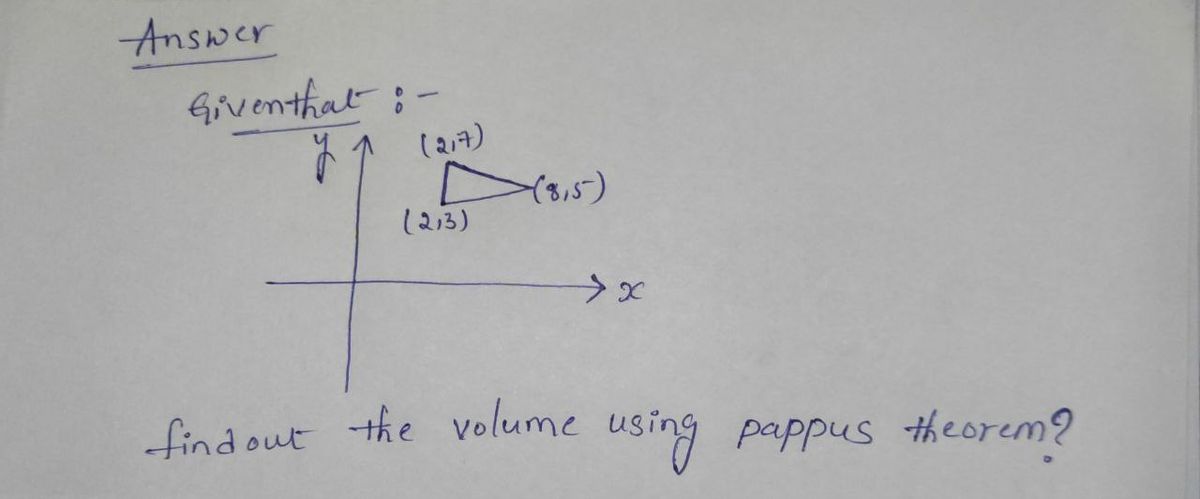Use the Theorem of Pappus to find the volume of the given solid. the solid obtained by rotating the triangle with vertices (2, 3), (2, 7), and (8, 5) about the x-axis 0
Use the Theorem of Pappus to find the volume of the given solid. the solid obtained by rotating the triangle with vertices (2, 3), (2, 7), and (8, 5) about the x-axis 0
Advanced Engineering Mathematics
10th Edition
ISBN:9780470458365
Author:Erwin Kreyszig
Publisher:Erwin Kreyszig
Chapter2: Second-order Linear Odes
Section: Chapter Questions
Problem 1RQ
Related questions
Question

Transcribed Image Text:**Volume of a Solid Using the Theorem of Pappus**
To find the volume of the given solid, use the Theorem of Pappus. The solid is obtained by rotating the triangle with vertices (2, 3), (2, 7), and (8, 5) around the x-axis.
**Diagram Explanation:**
The diagram shows a three-dimensional view of the solid formed by rotating a triangle around the x-axis. The triangle is highlighted in red with the following vertices:
- (2, 3)
- (2, 7)
- (8, 5)
After rotation, the solid appears as a three-dimensional object symmetric about the x-axis, resembling a cylinder with an elliptical cross-section. The rotation creates an ellipsoid shape as the triangle sweeps around the axis. The illustration depicts the y-axis vertically and x-axis horizontally, with the rotation of the triangle forming the solid shown in blue shading. The triangular cross-section is visible where the red triangle was initially before rotation.
Expert Solution
Step 1: Given data

Step by step
Solved in 4 steps with 4 images

Recommended textbooks for you

Advanced Engineering Mathematics
Advanced Math
ISBN:
9780470458365
Author:
Erwin Kreyszig
Publisher:
Wiley, John & Sons, Incorporated

Numerical Methods for Engineers
Advanced Math
ISBN:
9780073397924
Author:
Steven C. Chapra Dr., Raymond P. Canale
Publisher:
McGraw-Hill Education

Introductory Mathematics for Engineering Applicat…
Advanced Math
ISBN:
9781118141809
Author:
Nathan Klingbeil
Publisher:
WILEY

Advanced Engineering Mathematics
Advanced Math
ISBN:
9780470458365
Author:
Erwin Kreyszig
Publisher:
Wiley, John & Sons, Incorporated

Numerical Methods for Engineers
Advanced Math
ISBN:
9780073397924
Author:
Steven C. Chapra Dr., Raymond P. Canale
Publisher:
McGraw-Hill Education

Introductory Mathematics for Engineering Applicat…
Advanced Math
ISBN:
9781118141809
Author:
Nathan Klingbeil
Publisher:
WILEY

Mathematics For Machine Technology
Advanced Math
ISBN:
9781337798310
Author:
Peterson, John.
Publisher:
Cengage Learning,

